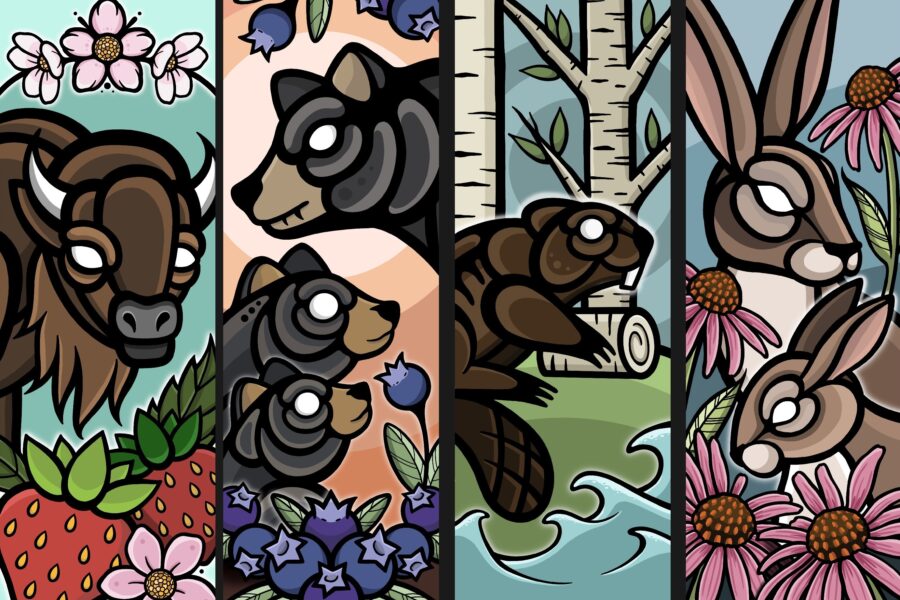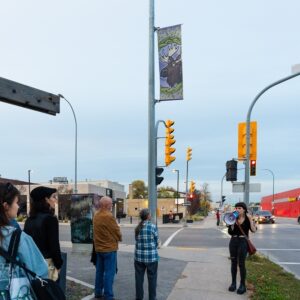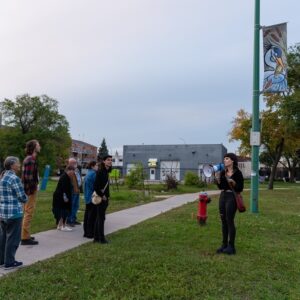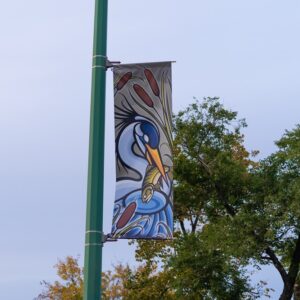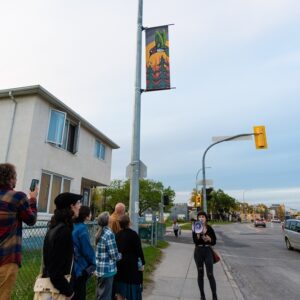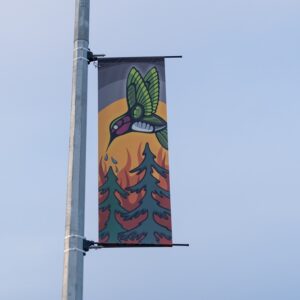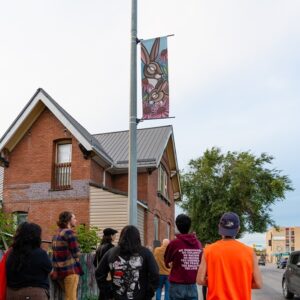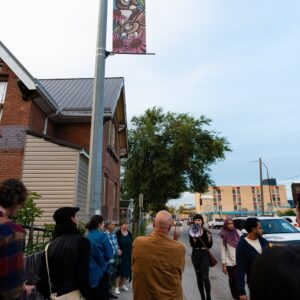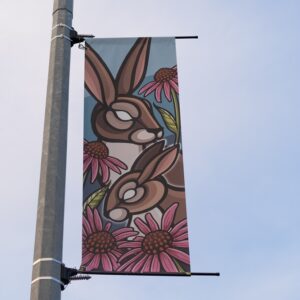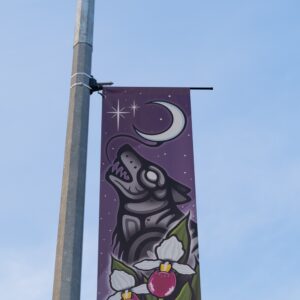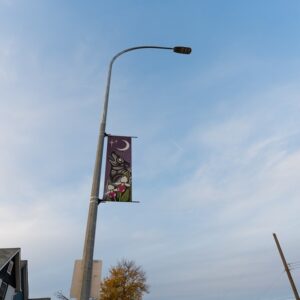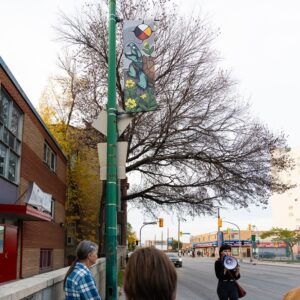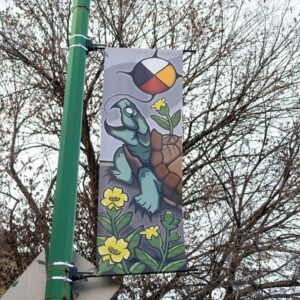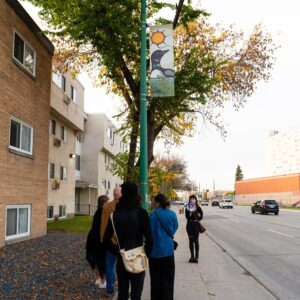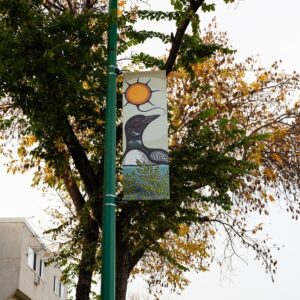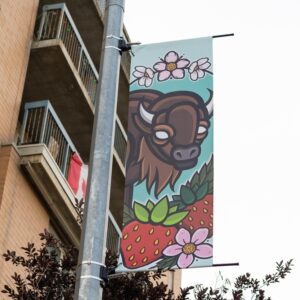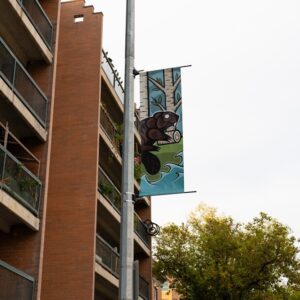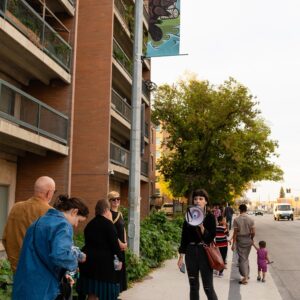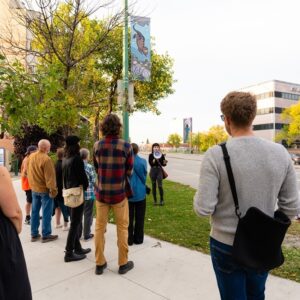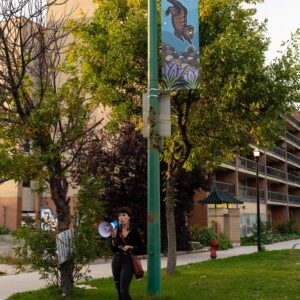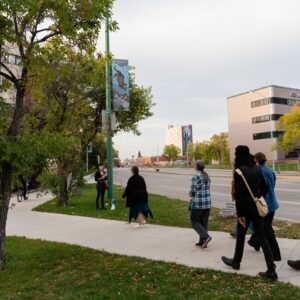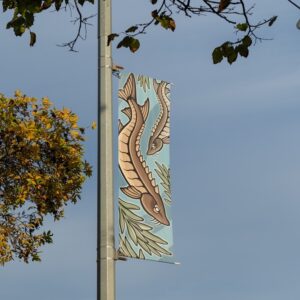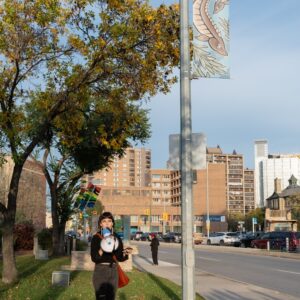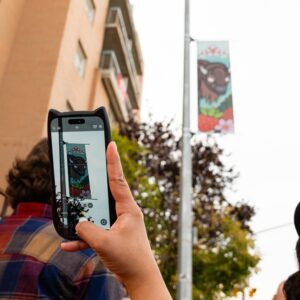Voices of the Land, the Balmoral Banner Project by Métis artist Justine Proulx highlights Woodland art and Indigenous teachings. This series of 12 designs uses vibrant imagery to share stories, encouraging reflection and dialogue between communities. Each banner features Manitoba animals and plants, symbolizing values like humility, courage, respect, and resilience. The project celebrates Indigenous knowledge while emphasizing universal values that connect all cultures.
As a project of the Winnipeg Arts Council and West End BIZ, the banners will be displayed for at least two years along Balmoral Street, between Ellice Avenue and Notre Dame, in Winnipeg’s West End. They invite viewers to explore Indigenous stories and contribute to a more inclusive and welcoming city.
The banners were officially launched with an artist-led walking tour on September 27, 2025.
The Banners
Wolf and Lady Slipper Flower
The Wolf represents Humility in the Seven Grandfather Teachings. Wolves live for their pack and have many family and community values that we can learn from. The wolf is a partner to humans and is considered a wise helper, instructing people on how to live together and care for one another. The Lady Slipper, also called the Moccasin Flower, is one of Manitoba’s protected flowers. It is slow-growing and slow to bloom, teaching us to take our time and take only what we need from the land. One story tells of how the Moccasin Flower came to be. It speaks of a young girl who traveled through a harsh winter to retrieve medicine for her sick people, as she was one of the only healthy ones. Along the rough journey through deep snowdrifts and blizzards, she lost her moccasins, exposing her bare feet to the snow and ice, leaving a bloodstained trail behind her. She returned to her community and delivered the medicine. The following spring, when they went to search for her lost moccasins, they found that beautiful pink flowers had grown along the trail where her bloody footprints had been. Today, we call this flower the Moccasin or Lady Slipper Flower.
Beaver and Birch Tree
Beavers represent Wisdom in the Seven Teachings. They use their natural gifts for survival and alter their environment for the benefit of their family. They raise their young closely and have strong family structures. They teach us to use our inherent gifts wisely. Birch trees have a long history with Indigenous people. Their bark was used for many purposes, including artwork and writing. A common Indigenous art form is “Birch Bark Biting,” where designs are carefully bitten into pieces of bark, often as a fun community activity. Birch bark is light, waterproof, and, when dried, becomes firm. The bark also has antibacterial properties. The Birch tree has many gifts to offer!
Hummingbird and Spruce Trees
The hummingbird is one of the tiniest birds in Manitoba, yet it plays a vital role in pollination and supporting the ecosystem. This banner visually represents a well-known teaching story. The story tells of a vast forest engulfed in a massive fire. All the animals flee and watch their home burn, feeling hopeless, powerless, and overwhelmed—except for one small hummingbird. Determined to help, the hummingbird flies to the nearest stream, filling its beak with as much water as it can carry—just a few drops. It returns to the fire, dropping the water onto the flames, then flies back and forth tirelessly. The larger animals stand by helplessly. Many of them could carry more water than the hummingbird, but instead, they say, “Why are you trying? What do you think you can do? You’re too small to make a difference.” The hummingbird turns to them and replies, “I am doing the best I can.”
Bison/Buffalo and Strawberries
The Buffalo represents Respect in the Seven Teachings. The buffalo is one of the most recognizable animals in Manitoba. It has given every part of its being to sustain human life. Buffalo were nearly wiped-out during colonization, but they teach us to take only what we need from the earth and to use every part of what is given to us. Their immense sacrifice is why we have the utmost respect for them. Strawberries are heart medicine. Just as the heart berry is connected to the strawberry plant by many leaves, stems, and flowers, our heart is connected to our body by veins, organs, and tissues. It reminds us to nurture heartfelt relationships and put our hearts into everything we do. Many Indigenous groups also consider strawberries a woman’s medicine. In some traditions, young women fast from berries for a year after their first menstrual cycle, during which time they learn from the women in their community about womanhood and the responsibility of sustaining their people.
Bear and Blueberries
Bears represent Courage in the Seven Teachings. Mother bears are among the most protective and maternal creatures on Earth. They have the courage and strength to defend their young, teaching us to live a balanced life of play, rest, and survival. They also guide us in defending what is right for ourselves, our families, and our communities. Bears frequently appear in dreams and visions as symbols of strength and guidance. Blueberries are often included in the Berry Fast alongside strawberries. They are commonly associated with bears, as they are one of their favourite foods. Berries symbolize community and gathering. A blueberry harvest is a communal activity, and blueberries were an essential food for Indigenous people. They dry well and can be stored for long periods, making them invaluable for survival.
Rabbit and Echinacea / Cone Flower
Rabbits and hares were essential sources of food and clothing for Indigenous people. Every part of them— the fur, meat, and bones—was used, with as little waste as possible. They are wise animals, and many Indigenous stories feature a trickster spirit called Nanabush or Nanabozho, who often takes the form of a rabbit. Echinacea, or the Cone Flower, grows natively across Manitoba and has many medicinal uses. It can treat wounds, sores, and internal ailments. Chewing the roots and seed heads helps with toothaches, sore throats, and colds. Echinacea is also known for its ability to boost the immune system.
Snapping Turtle and Tobacco Plant
Snapping turtles are associated with the Creation Story, new beginnings, wisdom, and Truth in the Seven Teachings. Tobacco is one of the Four Sacred Medicines of Indigenous people, and an offering given to the land, animals, or elders in exchange for knowledge and services.
Muskrat and Prairie Crocus Flower
The Muskrat is a very sacred animal, being the “hero” in the Creation Story. The Creation Story has many variations, but the central theme is the renewal of Earth. The Creator cleansed the world of feuding peoples to start anew. Some animals survived the flood, like the loon, muskrat, and turtle. Nanabush, a supernatural being, also survived and asked the animals to dive underwater to collect soil to recreate the Earth. One by one, the animals failed. The muskrat, mocked by others, dove deep and resurfaced with soil, though it lost its life in the process. Nanabush placed the soil on a turtle’s back, and from it, Turtle Island was created, the centre of life for all beings. Prairie Crocus flowers is the official flower of Manitoba. They are symbolic of new beginnings, spring, rebirth, and growth.
Moose and Sweetgrass
Moose are known for their strength and bravery, they are symbolic of warriors. Like the buffalo, they are sacred and can feed a large amount of people, and their antlers, hide, and bones can be used for so many purposes. They are also associated with the Moose Hide Campaign, a movement to engage men and boys against ending violence towards women/children. Sweetgrass is another one of the Four Sacred Medicines. Commonly braided after it’s picked, it is the sacred hair of Mother Earth. It is often used for smudging and connecting with ancestors.
Sturgeon Fish and Sage
Sturgeon fish are basically living fossils. They have been around forever, and used to be plentiful. They are now a protected species because of overfishing. They can live over 100 years and get 6 feet in length. They are symbolic of strength and a long life, as well as resilience. Sage is another of the Four Sacred Medicines. It is often used for preparing people for ceremonies, and is more medicinal than Sweetgrass. It is found all over Manitoba, and commonly used for smudging.
Great Blue Heron and Cattail
The Heron is very strong willed and determined. He represents strength as well as patience. He will wait for the right moment to get his prey. They also represent balance. Every part of a Cattail can be used as a food source or material. The shoots, flowers and roots can be eaten. The fluffy seed was used as a fire starter, and to stuff clothing and blankets. The stalks and leaves can be used to make baskets, rope, and even emergency shelters. The cattail has many uses and was a staple to Indigenous people.
Loon and Cedar
The loon dives and can see what is happening in the water, as well as on land. They are symbolic of being responsible for settling issues in their home communities, and to try and see all issues from all angles. The loon teaches us about dreams and wishes. They are built to swim and predominantly be in the water, and are between the spirit and physical world, since water is symbolic of dreams and multiple layers of consciousness. Cedar is the last of the Four Sacred Medicines. Cedar is also used for cleansing and smudging. Cedar is often burned during ceremony or sacred fires, and the crackling of the cedar calls the attention of the spirits that the offering is being made to.

